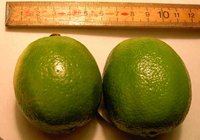Lime (fruit)
|
|
| Lime | ||||||||||||||||
|---|---|---|---|---|---|---|---|---|---|---|---|---|---|---|---|---|
 Lime fruit | ||||||||||||||||
| Scientific classification | ||||||||||||||||
|
Lime (Citrus x aurantifolia) is a citrus tree originating from the Malay Archipelago. The origin of the name lemon is Persian (from Persian لیمو Limu). This tree's fruit contains a very high level of vitamin C. British sailors were issued a daily allowance of lemons or limes to prevent scurvy, giving them the nickname Limey. Biologically, they are identical to lemons, except for certain chemicals being the chiral opposite (i.e. the mirror reflection), and arise as a mutation in lemon trees, or from seeds resulting from these.
This is a shrubby tree, to 5 m (16 ft). The trunk rarely grows straight, with many branches that often originate quite far down on the trunk. The leaves are ovate 2.5–9 cm (1–3.5 in) long, resembling orange leaves (the scientific name aurantifolia refers to the leaves' resemblance). The flowers are 2.5 cm (1 in) in diameter, are yellowish white with a light purple tinge on the margins. Flowers and fruit appear throughout the year but are most abundant from May to September.
Three_cut_limes.jpg
Limes are oval or globose bright green fruit with a sour, pungent flavor. If they stay on the tree for a long time they turn yellow and resemble a small roundish lemon. Lime juice is used in cooking and in soft drinks, and limeade (like lemonade). Alcoholic drinks closely associated with the lime include cocktails such as the mojito, and many varieties of tequila. Also beer is accompanied with limes in Mexico and other countries. Some like to eat them as fruits, as did British sailors. Miniature limes are commonly referred to as cocktail limes. Lime extracts and essential oils are frequently used in perfumes, cleansing products, and for aromatherapy.
For other meanings of the word lime, see Lime.da:Lime (Citrus aurantiifolia) de:Limette fr:Lime (fruit) ms:Limau Nipis ja:ライム simple:Lime sl:limeta fi:Limetti sv:Lime
